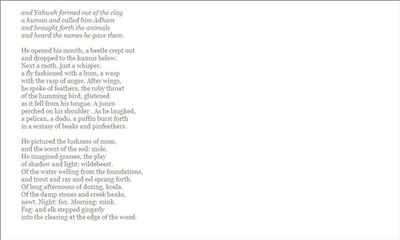What I learned from Kant today:
How liberating is the idea that art does not need to "do" something? It doesn't have to teach something; it doesn't have to fit some pre-conceived notion; it doesn't have to have some value as a product. We strive to create, even if what we create never achieves "beauty," we can at least be inspired by beauty to aim for the ideal. Its value does not lie in what it is used for, but rather in & for itself.
Do I believe all this? Is art in itself & for itself enough?
Draft
Since I can't help but be influenced by what I'm reading, here's another (Another!) Adam poem. (You'll need to click on the poem to read it. I'm still working on the technology aspects of blogging. ) This is my first draft and I'm not sure if I'll work on it further as the concept has been around the block a time or two before.

Draft:

Draft:
Why Metaphor?
Now the sources of all poetic locution are two: poverty of language and need to explain and be understood. [. . .] What Aristotle said of the individual man is therefore true of the race in general: Nihil est in intellectu quin prius fuerit in sensu. That is, the human mind does not understand anything of which it has no previous impression from the senses.
--Giambattista Vico, 1668-1744, The New Science
I understand what Vico is saying to mean that since we don't have the language to convey some experiences and because others cannot understand what they have not experienced (observed, touched, tasted, heard, smelled) that the best we can do is to use poetic language.
I like this argument for metaphor; that it can help us portray what language otherwise prevents us from conveying. Metaphor then helps us enact an experience by drawing on our previous experienced sensual data. I believe this is why blood, bone, moon and the like show up in so many poems, because these are concepts about which we all can quickly relate sensual data. It is more risky therefore (risking failure of communication) to use a metaphor with a vehicle which may be less familiar to the reader.
--Giambattista Vico, 1668-1744, The New Science
I understand what Vico is saying to mean that since we don't have the language to convey some experiences and because others cannot understand what they have not experienced (observed, touched, tasted, heard, smelled) that the best we can do is to use poetic language.
I like this argument for metaphor; that it can help us portray what language otherwise prevents us from conveying. Metaphor then helps us enact an experience by drawing on our previous experienced sensual data. I believe this is why blood, bone, moon and the like show up in so many poems, because these are concepts about which we all can quickly relate sensual data. It is more risky therefore (risking failure of communication) to use a metaphor with a vehicle which may be less familiar to the reader.
Subscribe to:
Posts (Atom)



